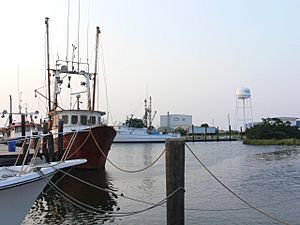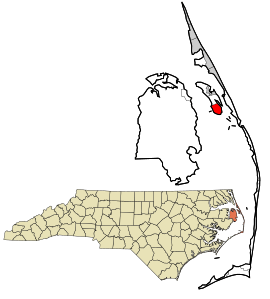Wanchese, North Carolina facts for kids
Quick facts for kids
Wanchese, North Carolina
|
|
|---|---|

Entrance to Wanchese Harbor
|
|

Location in Dare County and the state of North Carolina.
|
|
| Country | United States |
| State | North Carolina |
| County | Dare |
| Named for | Wanchese |
| Area | |
| • Total | 4.71 sq mi (12.20 km2) |
| • Land | 4.67 sq mi (12.08 km2) |
| • Water | 0.04 sq mi (0.11 km2) |
| Elevation | 7 ft (2 m) |
| Population
(2020)
|
|
| • Total | 1,522 |
| • Density | 326.26/sq mi (125.97/km2) |
| Time zone | UTC-5 (Eastern (EST)) |
| • Summer (DST) | UTC-4 (EDT) |
| ZIP code |
27981
|
| Area code(s) | 252 |
| FIPS code | 37-70920 |
| GNIS feature ID | 0996765 |
Wanchese (/ˈwɒntʃiːz/) is a small community in North Carolina, United States. It's located on Roanoke Island in Dare County. The town is named after Wanchese, a Native American leader from the Roanoke tribe. English explorers met him in the 1500s.
In 2010, about 1,642 people lived in Wanchese. Today, it's a major hub for commercial fishing and building boats in the Outer Banks. The local government for Wanchese is the Dare County Board of Commissioners. Wanchese is part of District 1, along with nearby towns like Manteo.
Contents
Where is Wanchese Located?
Wanchese is found at the southern end of Roanoke Island. Its exact location is 35°50′42″N 75°38′22″W / 35.845046°N 75.639544°W.
The community covers about 5.5 square miles (14.2 square kilometers). Most of this area is land, about 4.7 square miles (12.2 square kilometers). The rest, about 0.8 square miles (2.1 square kilometers), is water.
A Look at Wanchese History
You can also learn more at: History of Roanoke Island
Scientists have found old evidence showing that Wanchese was once the site of the very first fishing village on Roanoke Island. Indigenous people lived here about 1,500 years ago. They used this spot for fishing for over 1,100 years. They also gathered oysters and other shellfish from the nearby waters.
The Tillett Site Discoveries
A special place called the Tillett Site shows how people lived long ago. It was first used when Roanoke Island was still connected to the mainland. This was during the Archaic Period, from 8000 to 1000 BC.
Later, the sea level rose, and the area became an island. The water became salty, which was perfect for the local fishing cultures. This included the historic Roanoke tribe.
Scientists found signs of three main times when people lived at the Tillett site:
- Mount Pleasant period: Around 400 to 800 AD.
- Colington period: From 800 to 1650. This shows the early culture of the Carolina Algonquian people.
- Historic period: Mostly from 1884 to 1910/20. During this time, the Green family used the site as a farm. People also continued to fish here.
During the first two periods, the Tillett site was a place where people stayed for part of the year. The Roanoke people came from the mainland to fish and collect shellfish. When English explorers arrived, the Algonquian-speaking Roanoke tribe still used the site for seasonal fishing. Their main town was on the western side of Croatan Sound.
After English settlers permanently moved to the area in the 1650s, people continued to use the site for fishing. In the 1800s, Wanchese had the only lighthouse on Roanoke Island. It was called Marshes Light. A copy of this lighthouse has since been rebuilt in Manteo. In the 1980s, plans were made to turn Wanchese into a large commercial fishing port. It would also have a facility for processing seafood.
Who Lives in Wanchese?
| Historical population | |||
|---|---|---|---|
| Census | Pop. | %± | |
| 2010 | 1,642 | — | |
| 2020 | 1,522 | −7.3% | |
| U.S. Decennial Census | |||
The latest count in 2020 showed that 1,522 people lived in Wanchese. There were 683 households and 488 families.
Learning in Wanchese
Students in Wanchese go to schools run by Dare County Schools. The local schools include Manteo Elementary School, Manteo Middle School, and Manteo High School.
See also
 In Spanish: Wanchese (Carolina del Norte) para niños
In Spanish: Wanchese (Carolina del Norte) para niños



